Research on Reservoir Optimal Operation Based on Long-Term and Mid-Long-Term Nested Models
Abstract
1. Introduction
2. Materials and Methods
2.1. Data Sources
2.1.1. Basic Overview of the River Basin
2.1.2. General Situation of Chengbi River Reservoir Project
2.2. Optimization Scheduling Nested Model
2.2.1. Optimize Scheduling Nested Model Concept
2.2.2. The Objective Function
2.2.3. Constraint Condition
- (1)
- Water balance equation
- (2)
- Capacity constraints
- (3)
- Water level constraints
- (4)
- Lower discharge constraint
- (5)
- Output constraintswhere and are, respectively, the water storage capacity of the reservoir at the beginning and end of time, m3; , and are, respectively, the reservoir inflow flow, power generation flow and lower discharge flow of the first period, m3/s; and are the lower limit and upper limit of the reservoir water storage at the end of the period, m3. In the long-term power generation scheduling, is generally the dead storage capacity. In the flood season, represents the storage capacity corresponding to the flood limit water level, and in the dry season, represents the storage capacity corresponding to the normal water level. In the mid-long-term scheduling, the storage capacity in the post-flood season determined by the long-term scheduling is used as the boundary. and are the highest and lowest water levels allowed by the reservoir, m. In long-term scheduling, is generally taken the flood limit water level during the flood season, and it is taken the normal storage water level during the dry season, and is generally taken the dead water level. In the mid-long-term scheduling, the post-flood season water level determined by the long-term scheduling is used as the boundary for constraints; is the upper limit of discharge under the reservoir, m3/s; and are, respectively, the maximum and minimum outputs of the power station, kW.
2.2.4. Model Solving Method
2.3. The Evaluation Index
3. Results and Discussion
3.1. Application Results of Nested Optimization Scheduling Model in Typical Years
3.2. Application Results of Optimal Scheduling Nested Model from 2005 to 2014
3.3. Comparison Results of Evaluation Indexes of Three Different Control Modes
3.3.1. Qualitative Analysis of Evaluation Indicators
3.3.2. Quantitative Analysis of Evaluation Indicators
4. Conclusions
Author Contributions
Funding
Informed Consent Statement
Data Availability Statement
Conflicts of Interest
References
- Wang, R. Study on the Added-Value of Water Resources under the Life-Cycle Condition. Ph.D. Thesis, Chinese Academy of Agricultural Sciences, Beijing, China, 2011. [Google Scholar]
- Pallavi, S.; Yashas, S.R.; Anilkumar, K.M.; Shahmoradi, B.; Shivaraju, H.P. Comprehensive Understanding of Urban Water Supply Management: Towards Sustainable Water-socio-economic-health-environment Nexus. Water Resour. Manag. 2021, 35, 315–336. [Google Scholar] [CrossRef]
- Mostafa, S.M.; Wahed, O.; El-Nashar, W.Y.; El-Marsafawy, S.M.; Zeleňáková, M.; Abd-Elhamid, H.F. Potential Climate Change Impacts on Water Resources in Egypt. Water 2021, 13, 1715. [Google Scholar] [CrossRef]
- Eirini, A.; Naoum, T. Investigating dynamic interconnections between organic farming adoption and freshwater sustainability. J. Environ. Manag. 2021, 294, 112896. [Google Scholar] [CrossRef]
- Hu, W.; Tian, J.; Chen, L. Assessment of sustainable water stewardship and synergistic environmental benefits in Chinese industrial parks. Resour. Conserv. Recycl. 2021, 170, 105589. [Google Scholar] [CrossRef]
- Mahmoodi, N.; Kiesel, J.; Wagner, P.D.; Fohrer, N. Integrating water use systems and soil and water conservation measures into a hydrological model of an Iranian Wadi system. J. Arid Land 2020, 12, 545–560. [Google Scholar] [CrossRef]
- Zhou, Y.; Sharma, A.; Masud, M.; Gaba, G.S.; Dhiman, G.; Ghafoor, K.Z.; AlZain, M.A. Urban Rain Flood Ecosystem Design Planning and Feasibility Study for the Enrichment of Smart Cities. Sustainability 2021, 13, 5205. [Google Scholar] [CrossRef]
- Andrea, G.; Diego, A.; Alberto, B.; Bruno, M. Detailed simulation of storage hydropower systems in large Alpine watersheds. J. Hydrol. 2021, 603, 127125. [Google Scholar] [CrossRef]
- Gong, Y.; Liu, P.; Cheng, L.; Chen, G.; Zhou, Y.; Zhang, X.; Xu, W. Determining dynamic water level control boundaries for a multi-reservoir system during flood seasons with considering channel storage. J. Flood Risk Manag. 2020, 13, 12586. [Google Scholar] [CrossRef]
- Jiang, Z.; Qin, H.; Ji, C.; Feng, Z.; Zhou, J. Two Dimension Reduction Methods for Multi-Dimensional Dynamic Programming and Its Application in Cascade Reservoirs Operation Optimization. Water 2017, 9, 634. [Google Scholar] [CrossRef]
- Ji, C.; Li, C.; Wang, B.; Liu, M.; Wang, L. Multi-Stage Dynamic Programming Method for Short-Term Cascade Reservoirs Optimal Operation with Flow Attenuation. Water Resour. Manag. 2017, 31, 4571–4586. [Google Scholar] [CrossRef]
- He, S.; Tan, Q.; Lei, X.; Li, H.; Wang, X.; Yang, M.; Zhang, P. Real-time water-ssupply optimal operation in Li River Basin. South-North Transf. Water Sci. Technol. 2018, 16, 98–103. [Google Scholar]
- Zhu, J.; Zhang, H.; Xin, C.; Zhang, L. PSO Model and Calculation Method to Reservoir Optimal Operation. Syst. Eng. 2010, 28, 105–112. [Google Scholar]
- Liu, D.; Wang, M.; Li, X.; Wu, W.; Zhang, L.; Li, H. Hydropower market electricity distribution model based on large system decomposition theory. IOP Conf. Ser. Earth Environ. Sci. 2018, 189, 052079. [Google Scholar] [CrossRef]
- Arne, H.; Stefan, R.; Clemens, T. Approximation Methods for Multiobjective Optimization Problems: A Survey. INFORMS J. Comput. 2021, 33, 1259–1684. [Google Scholar] [CrossRef]
- Yue, W.; Luh, H.; Li, D. Preface–Special Issue on Recent Developments in Operations Research: Theory and Applications. J. Oper. Res. Soc. China 2020, 8, 533–535. [Google Scholar] [CrossRef]
- Wu, H.; Bai, Y. Optimization Model and Application of Long-term Operations of Reservoir Group of Hydropower Station. Water Power 2008, 1, 82–85. [Google Scholar]
- Muhamad, N.A.Z.; Marlinda, A.M.; Maslina, Z.; Ali, N.A. Application of artificial intelligence algorithms for hourly river level forecast: A case study of Muda River, Malaysia. Alex. Eng. J. 2021, 60, 4015–4028. [Google Scholar] [CrossRef]
- Chen, S. Variable sets and the theorem and method of optimal decision making for water resource system. J. Hydraul. Eng. 2012, 43, 1066–1074. [Google Scholar]
- Zhang, D.; Lin, J.; Peng, Q.; Wang, D.; Yang, T.; Sorooshian, S.; Liu, X.; Zhuang, J. Modeling and simulating of reservoir operation using the artificial neural network, support vector regression, deep learning algorithm. J. Hydrol. 2018, 565, 720–736. [Google Scholar] [CrossRef]
- Li, W.; Zhang, X.; Mbanze, D.E.; Wu, W. Research on Long-term Stochastic Optimal Operation of Reservior Based on SARSA Algorithm. Water Resour. Power 2018, 36, 72–75. [Google Scholar]
- Shokri, A.; Haddad, O.B.; Mariño, M.A. Algorithm for Increasing the Speed of Evolutionary Optimization and its Accuracy in Multi-objective Problems. Water Resour. Manag. 2013, 27, 2231–2249. [Google Scholar] [CrossRef]
- Ucler, N.; Engin, G.O.; Kocken, H.G.; Oncel, M.S. Game theory and fuzzy programming approaches for bi-objective optimization of reservoir watershed management: A case study in Namazgah reservoir. Environ. Sci. Pollut. Res. Int. 2015, 22, 6546–6558. [Google Scholar] [CrossRef]
- Tinoco, V.; Willems, P.; Wyseure, G.; Cisneros, F. Evaluation of reservoir operation strategies for irrigation in the Macul Basin, Ecuador. J. Hydrol. Reg. Stud. 2016, 5, 213–225. [Google Scholar] [CrossRef][Green Version]
- Celeste, A.B.; Suzuki, K.; Kadota, A. Integrating Long- and Short-Term Reservoir Operation Models via Stochastic and Deterministic Optimization: Case Study in Japan. J. Water Resour. Plan. Manag. 2008, 134, 440–448. [Google Scholar] [CrossRef]
- Jiang, Z.; Ji, C.; Sun, P.; Wang, L.; Zhang, Y. The Application of Multilayer Nested Parallel Dynamic Programming Algorithm in Cascade Reservoirs Operation Optimization. China Rural Water Hydropower 2014, 9, 70–75. [Google Scholar]
- Liu, Q.; Ma, G.; Liu, Q.; Jin, J. Application of nested aglorithm with bisection-interpolation approach and chaos to optimization of cascade reservoir operation. J. Hydraul. Eng. 2008, 2, 146–150. [Google Scholar]
- Hammid, A.T.; Awad, O.I.; Sulaiman, M.H.; Gunasekaran, S.S.; Mostafa, S.A.; Kumar, N.M.; Khalaf, B.A.; Al-Jawhar, Y.A.; Abdulhasan, R.A. A Review of Optimization Algorithms in Solving Hydro Generation Scheduling Problems. Energies 2020, 13, 2787. [Google Scholar] [CrossRef]
- Avesani, D.; Zanfei, A.; Di Marco, N.; Galletti, A.; Ravazzolo, F.; Righetti, M.; Majone, B. Short-term hydropower optimization driven by innovative time-adapting econometric model. Appl. Energy 2022, 310, 118510. [Google Scholar] [CrossRef]
- Ahmad, S.K.; Hossain, F. Forecast-informed hydropower optimization at long and short-time scales for a multiple dam network. J. Renew. Sustain. Energy 2020, 12, 014501. [Google Scholar] [CrossRef]
- Cassagnole, M.; Ramos, M.-H.; Zalachori, I.; Thirel, G.; Garçon, R.; Gailhard, J.; Ouillon, T. Impact of the quality of hydrological forecasts on the management and revenue of hydroelectric reservoirs—A conceptual approach. Hydrol. Earth Syst. Sci. 2021, 25, 1033–1052. [Google Scholar] [CrossRef]
- Xu, W.; Zhang, C.; Peng, Y.; Fu, G.; Zhou, H. A two stage Bayesian stochastic optimization model for cascaded hydropower systems considering varying uncertainty of flow forecasts. Water Resour. Res. 2014, 50, 9267–9286. [Google Scholar] [CrossRef]
- Stergiadi, M.; Marco, N.D.; Avesani, D.; Righetti, M.; Borga, M. Impact of Geology on Seasonal Hydrological Predictability in Alpine Regions by a Sensitivity Analysis Framework. Water 2020, 12, 2255. [Google Scholar] [CrossRef]
- Harrigan, S.; Prudhomme, C.; Parry, S.; Smith, K.; Tanguy, M. Benchmarking ensemble streamflow prediction skill in the UK. Hydrol. Earth Syst. Sci. 2018, 22, 2023–2039. [Google Scholar] [CrossRef]
- Arsenault, R.; Côté, P. Analysis of the effects of biases in ensemble streamflow prediction (ESP) forecasts on electricity production in hydropower reservoir management. Hydrol. Earth Syst. Sci. 2019, 23, 2735–2750. [Google Scholar] [CrossRef]
- Lamontagne, J.R.; Stedinger, J.R. Generating Synthetic Streamflow Forecasts with Specified Precision. J. Water Resour. Plan. Manag. 2018, 144, 04018007. [Google Scholar] [CrossRef]
- Mujumdar, P.P.; Nirmala, B. A Bayesian Stochastic Optimization Model for a Multi-Reservoir Hydropower System. Water Resour. Manag. 2007, 21, 1465–1485. [Google Scholar] [CrossRef]
- Filippini, M.; Squarzoni, G.; Waele, J.D.; Fiorucci, A.; Vigna, B.; Grillo, B.; Riva, A.; Rossetti, S.; Zini, L.; Casagrande, G.; et al. Differentiated spring behavior under changing hydrological conditions in an alpine karst aquifer. J. Hydrol. 2018, 556, 572–584. [Google Scholar] [CrossRef]
- Ahmad, A.; El-Shafie, A.; Razali, S.F.M.; Mohamad, Z.S. Reservoir Optimization in Water Resources: A Review. Water Resour. Manag. 2014, 28, 3391–3405. [Google Scholar] [CrossRef]
- Zhou, T. Research of Reservoirs and Hydropower Stations Optimal Operation and Benefit Evaluation. Ph.D. Thesis, North China Electric Power University, Beijing, China, 2014. [Google Scholar]
- Nikas, A.; Fountoulakis, A.; Forouli, A.; Doukas, H. A robust augmented ε-constraint method (AUGMECON-R) for finding exact solutions of multi-objective linear programming problems. Oper. Res. 2020, 1–42. [Google Scholar] [CrossRef]
- Gao, S.; Teng, Y.; Chen, Z. Short-term optimization operation of hydropower station group of Huangbo River Basin. Eng. J. Wuhan Univ. 2008, 2, 15–18. [Google Scholar]
- Xu, W.; Peng, Y.; Zhang, C.; Wang, B. Stochastic optimization operation for cascade hydropower reservoirs by using precipitation forecasts II.Coupling short and medium-term information. J. Hydraul. Eng. 2013, 44, 1189–1196, 1203. [Google Scholar]
- Jia, J.; Zhao, Q.; Guan, X.; Wu, H.; Li, Q. Mixed Integer Programming Based Method for Short-Term Scheduling of Hydroelectric Plants. J. Xi’an Jiaotong Univ. 2008, 8, 1006–1009. [Google Scholar]
- Sun, P.; Wang, L.; Jiang, Z.; Ji, C.; Zhang, Y. Application of two multi-dimensional dynamic programming algorithms in optimization of cascade reservoirs operation. J. Hydraul. Eng. 2014, 45, 1327–1335. [Google Scholar]
- Wang, L.; Wang, B.; Li, C.; Liu, M.; Zhang, Y. Reservoir stochastic optimization scheduling research based on Bayesian statistics and MCMC. J. Hydraul. Eng. 2016, 47, 1143–1152. [Google Scholar]
- Wang, X.; Lei, X.; Jiang, Y.; Wang, H. Reservoir operation chart optimization searching in feasible region based on Genetic Algorithms. J. Hydraul. Eng. 2013, 44, 26–34. [Google Scholar]
- Li, G.; Zou, J.; Zhang, B. The Genetic Algorithm Simulated Annealing of Large Probability of Mutation and its Application in Reservoir Optimization. China Rural Water Hydropower 2010, 3, 148–151. [Google Scholar]
- Ren, M.; He, X.; Ding, l.; Wang, H.; Li, H.; Tan, Y. Research and application of staged dynamic controlling domain of limited reservoir water level in flood season based on the improved predischarge capacity constrained method. J. China Inst. Water Resour. Hydropower Res. 2018, 16, 16–22. [Google Scholar]
- Zou, Q.; Wang, X.; Li, A.; He, X.; Luo, B. Optimal operation of flood control for cascade reservoirs based on Parallel Chaotic Quantum Particle Swarm Optimization. J. Hydraul. Eng. 2016, 47, 967–976. [Google Scholar]
- Zhang, X.; Dong, Z.; Ma, H. Study on Optimization Operation of Xiaolangdi Reservoir Based on Improved Multi-objective Genetic Algorithm. Water Resour. Power 2018, 1, 65–68. [Google Scholar]
- Yan, X.; Wang, L.; Yu, H.; Ji, C. Comparative Study on Three Implementation Modes of Reservoir Optimal Optimal Operation Scheme. Water Resour. Power 2019, 37, 61–64, 44. [Google Scholar]
- Chen, L.; Liu, C.; Yang, C.; Hao, F. Baseflow estimation of the source regions of the Yellow River. Geogr. Res. 2006, 25, 659–665. [Google Scholar]
- Shaligram, V.M.; Lele, V.S. Analysis of Hydrologic Data Using Pearson Type III Distribution. Hydrol. Res. 1978, 9, 31–42. [Google Scholar] [CrossRef]
- Nguyen, T.V.; In-Na, N. Plotting formula for pearson type III distribution considering historical information. Environ. Monit. Assess. 1992, 23, 17–152. [Google Scholar] [CrossRef]
- Stanislav, P.; Daniel, M. The Impact of the Uncertain Input Data of Multi-Purpose Reservoir Volumes under Hydrological Extremes. Water 2021, 13, 1389. [Google Scholar]
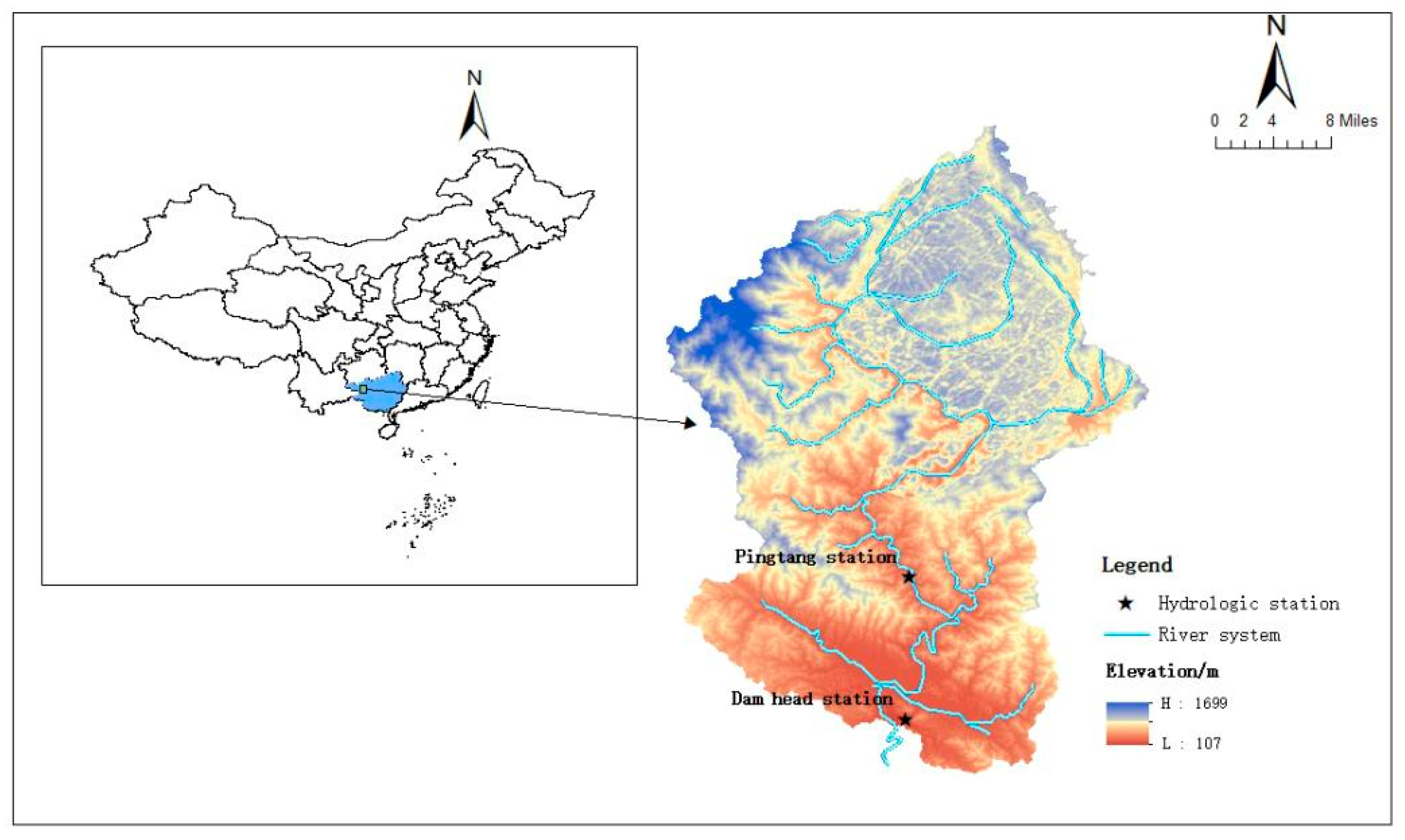
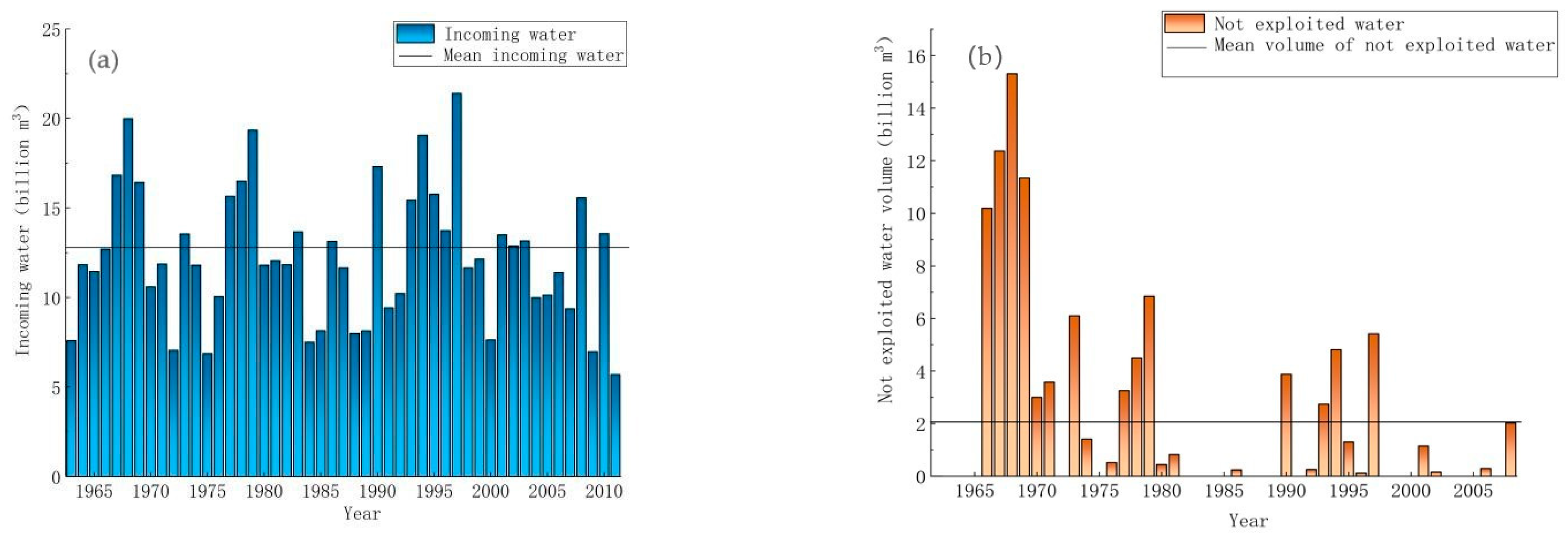
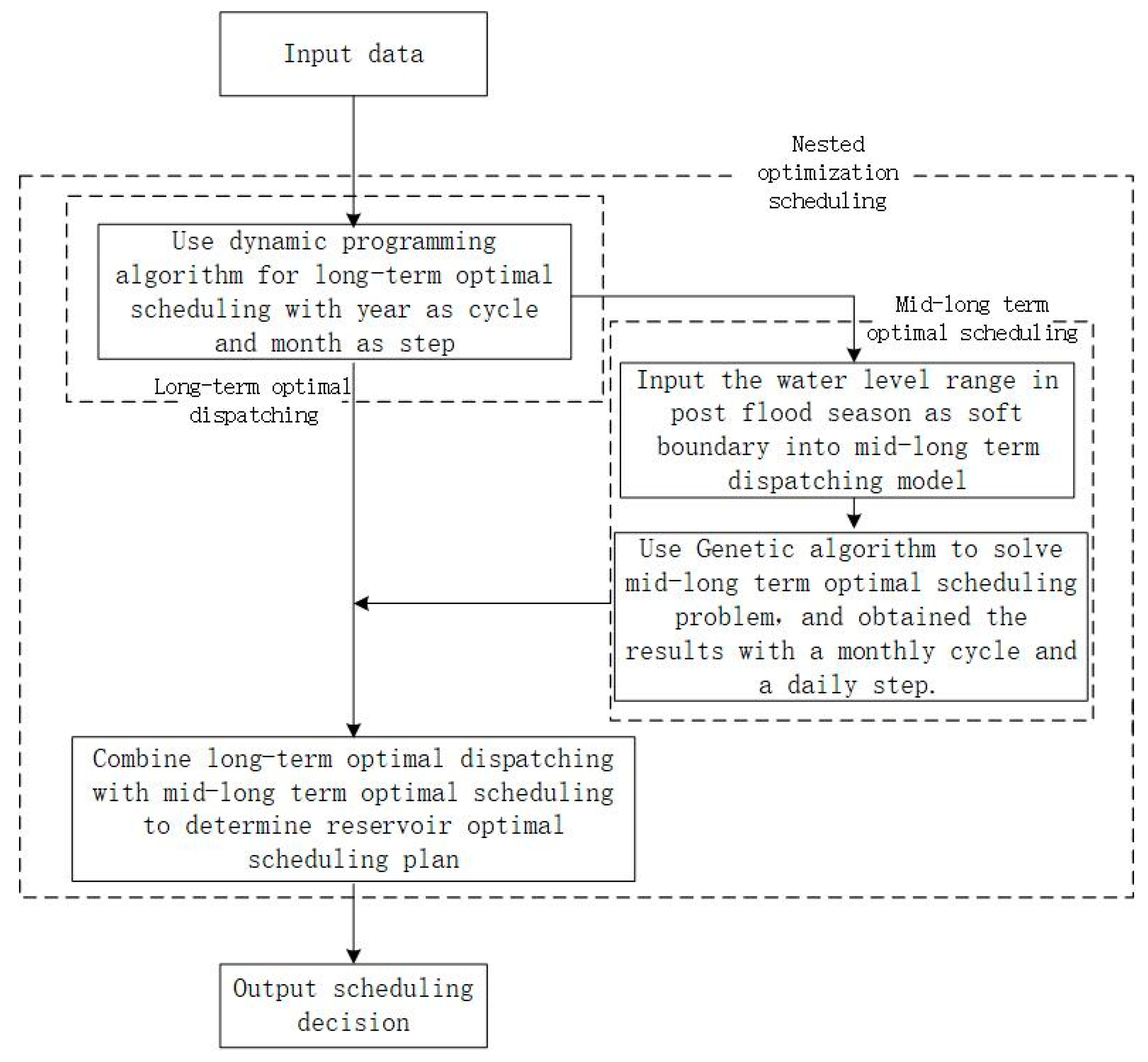
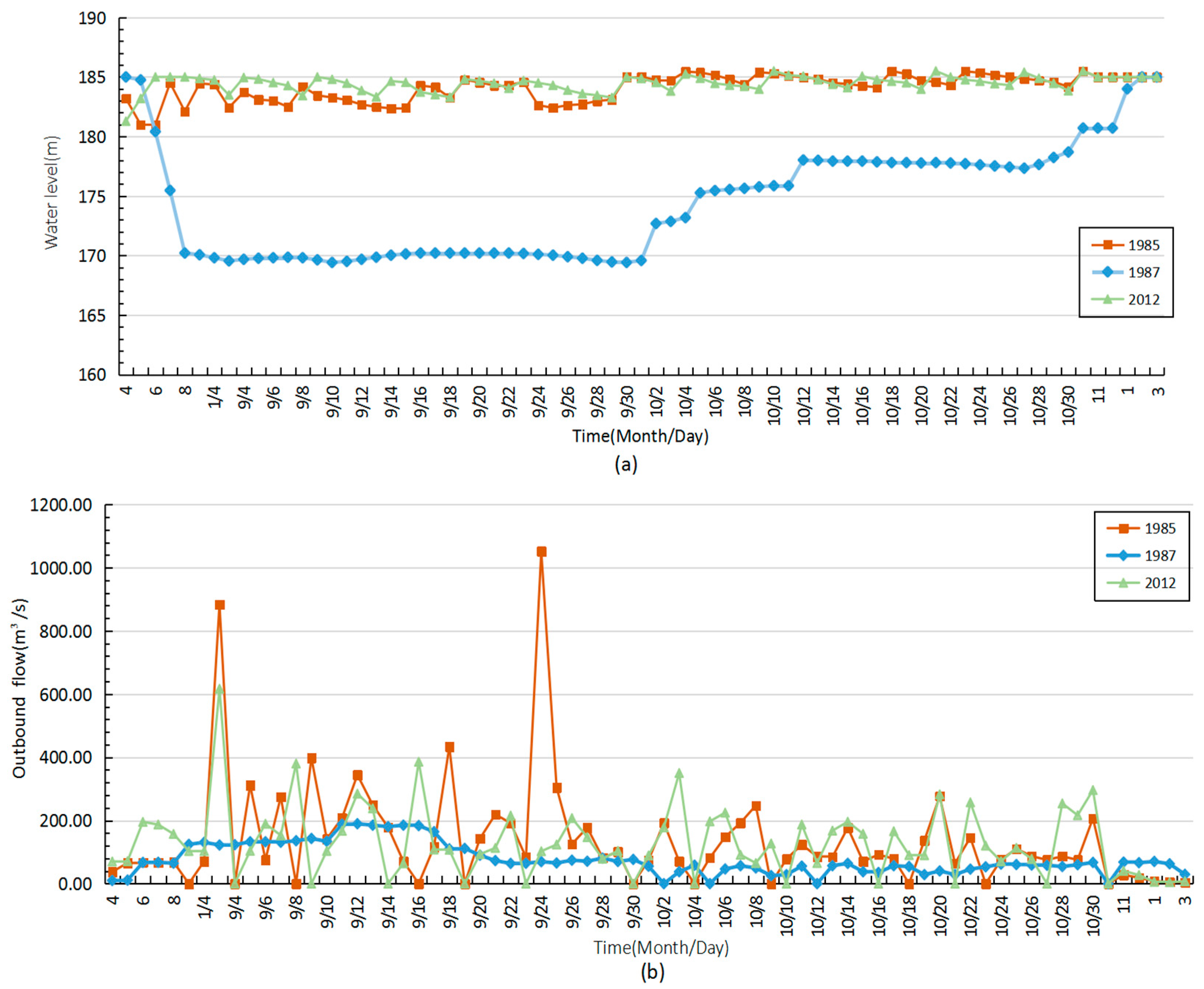
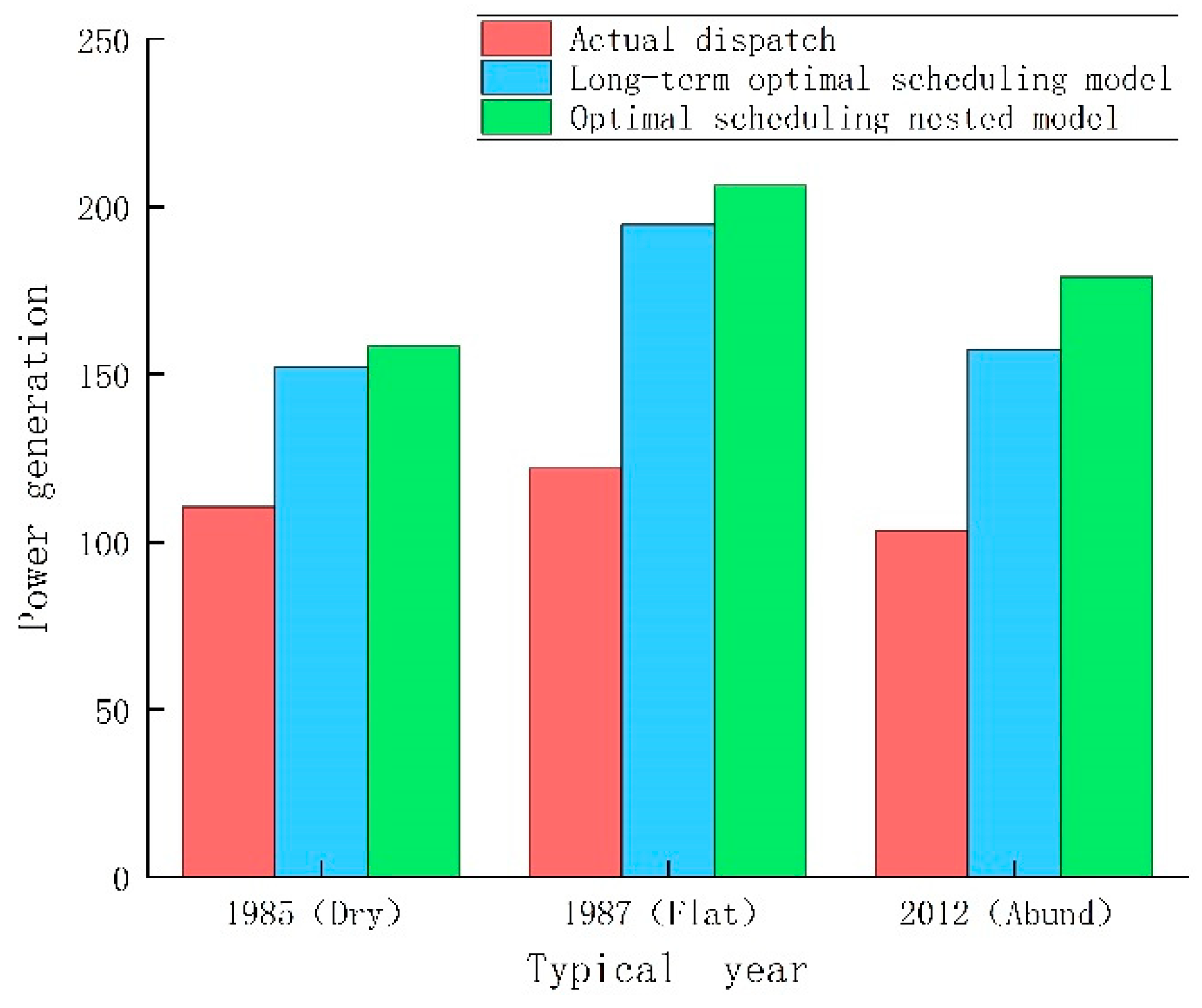
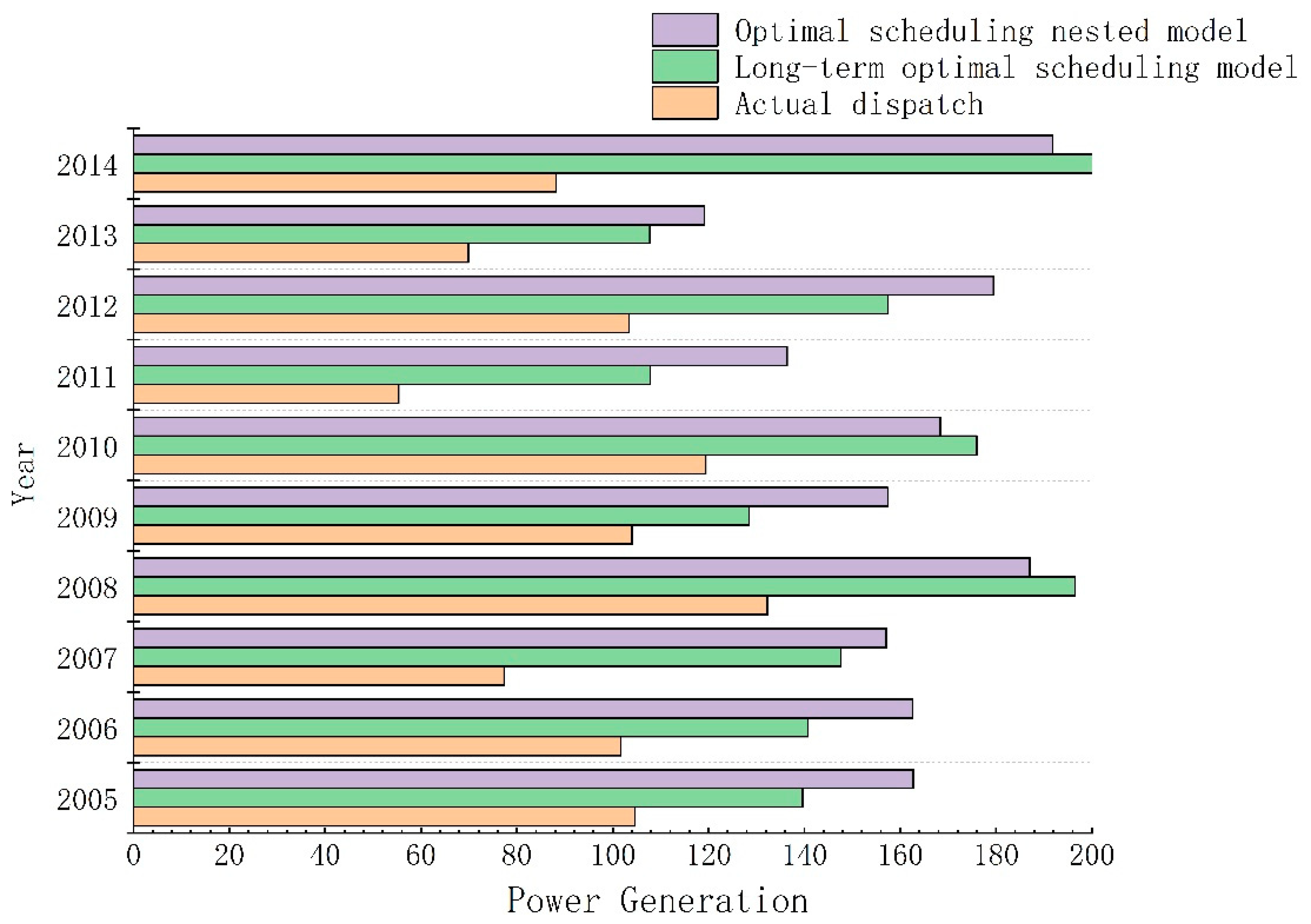
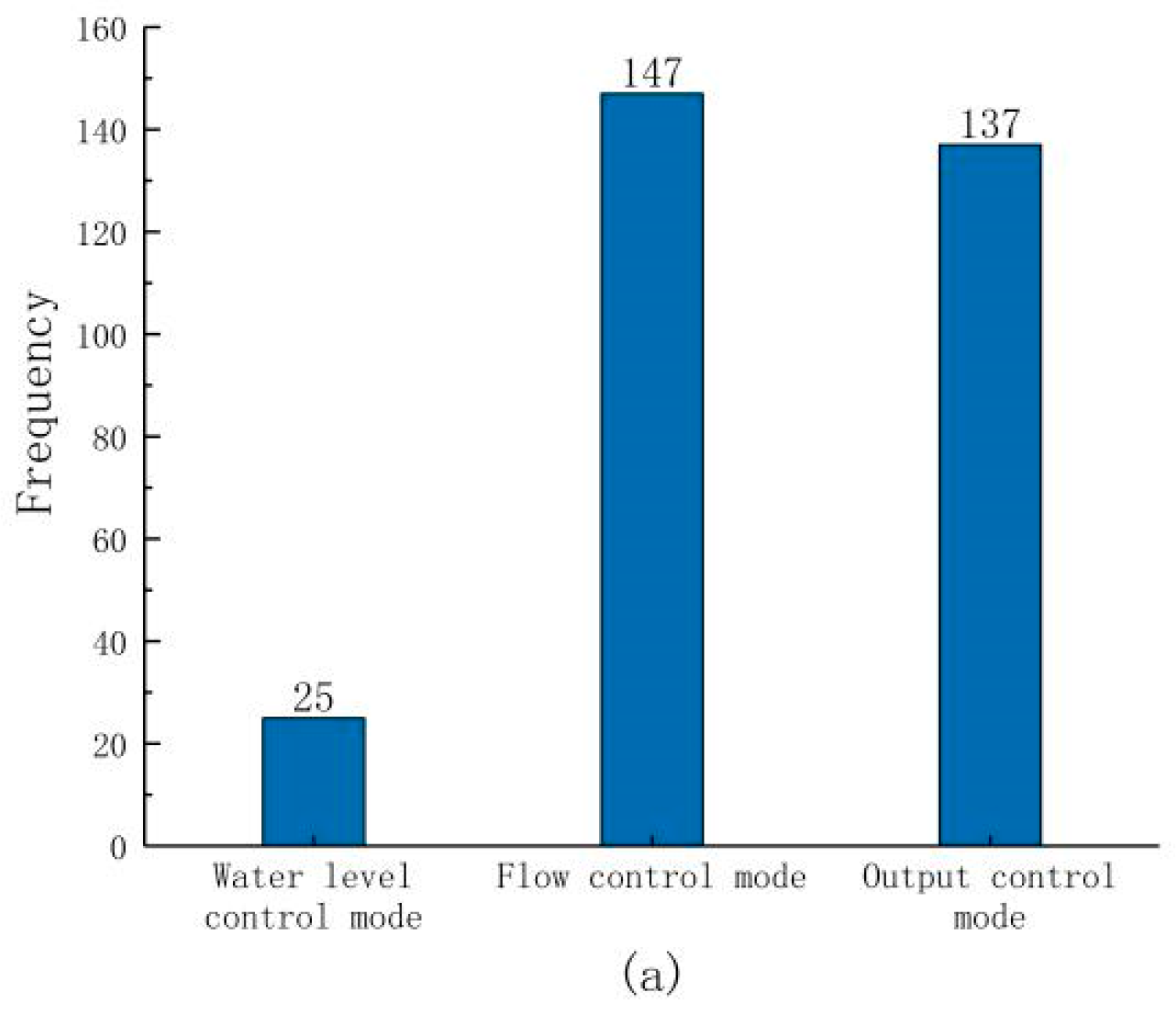
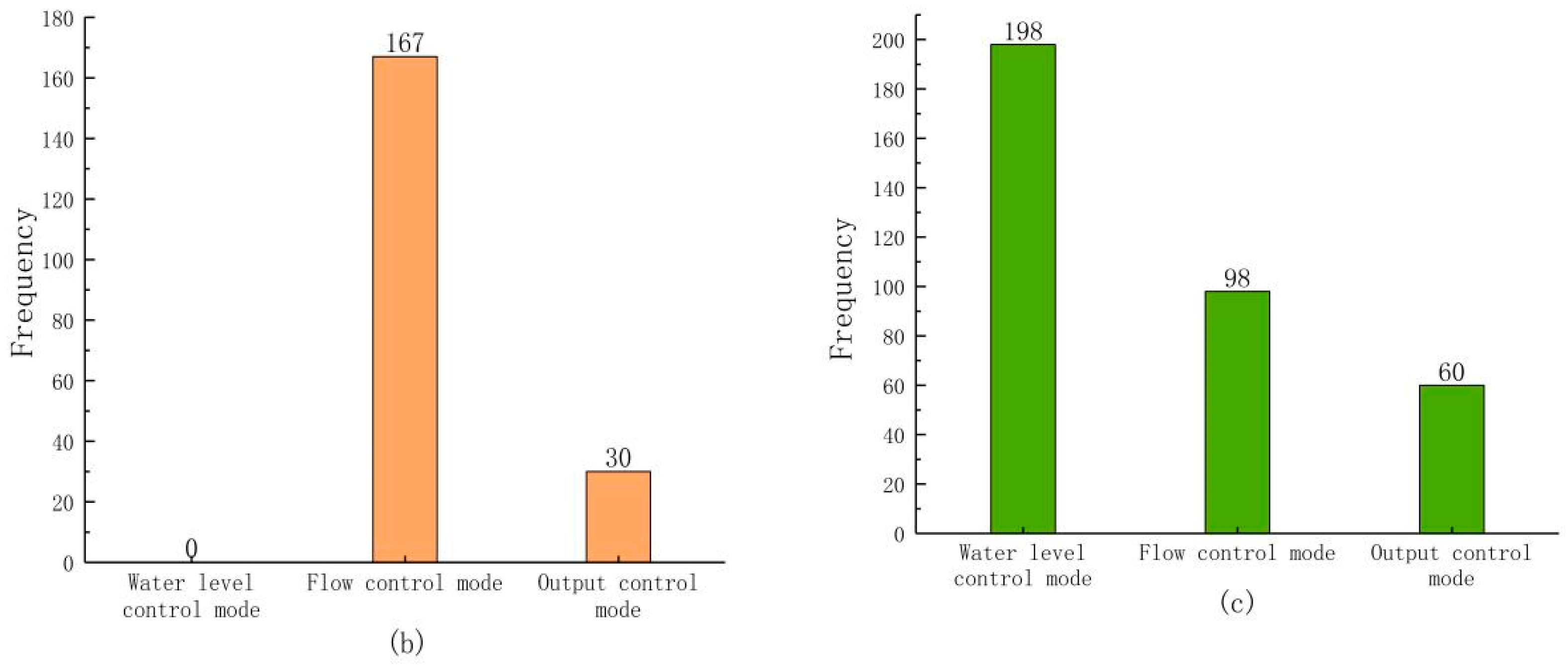
| Year | Capacity Storage Rate | Year | Capacity Storage Rate | Year | Capacity Storage Rate |
|---|---|---|---|---|---|
| 1963 | 0.34 | 1980 | 1.03 | 1997 | 0.96 |
| 1964 | 0.59 | 1981 | 0.79 | 1998 | 0.94 |
| 1965 | 0.58 | 1982 | 0.70 | 1999 | 0.94 |
| 1966 | 0.48 | 1983 | 0.76 | 2000 | 0.41 |
| 1967 | 0.48 | 1984 | 0.52 | 2001 | 1.09 |
| 1968 | 0.22 | 1985 | 0.57 | 2002 | 1.13 |
| 1969 | 0.34 | 1986 | 1.05 | 2003 | 0.95 |
| 1970 | 0.76 | 1987 | 0.92 | 2004 | 0.84 |
| 1971 | 0.68 | 1988 | 0.76 | 2005 | 0.71 |
| 1972 | 0.53 | 1989 | 0.48 | 2006 | 1.02 |
| 1973 | 0.34 | 1990 | 1.01 | 2007 | 0.88 |
| 1974 | 0.83 | 1991 | 0.83 | 2008 | 1.01 |
| 1975 | 0.57 | 1992 | 1.03 | 2009 | 0.84 |
| 1976 | 0.81 | 1993 | 1.00 | 2010 | 0.80 |
| 1977 | 0.99 | 1994 | 1.00 | 2011 | 0.34 |
| 1978 | 0.89 | 1995 | 0.99 | ||
| 1979 | 0.87 | 1996 | 0.96 |
| Year | Scheduling Model | 1–3 | 9 | 10 | 11–12 | Total |
|---|---|---|---|---|---|---|
| 1985 (Dry) | Actual dispatch | 46.02 | 8.36 | 8.15 | 13.91 | 110.50 |
| Long-term optimal scheduling model | 106.36 | 21.95 | 7.71 | 16.05 | 152.07 | |
| Optimal scheduling nested model | 106.36 | 18.00 | 18.00 | 16.05 | 158.41 | |
| 1987 (Flat) | Actual dispatch | 80.39 | 7.40 | 12.31 | 21.77 | 121.86 |
| Long-term optimal scheduling model | 122.17 | 16.76 | 19.29 | 43.35 | 194.63 | |
| Optimal scheduling nested model | 122.17 | 20.16 | 20.88 | 43.35 | 206.56 | |
| 2012 (Abund) | Actual dispatch | 63.45 | 13.09 | 8.83 | 18.07 | 103.44 |
| Long-term optimal scheduling model | 120.49 | 8.07 | 5.58 | 23.34 | 157.48 | |
| Optimal scheduling nested model | 120.49 | 18.00 | 17.28 | 23.34 | 179.11 |
| Control Modes | Power Generation Benefit (GW·h) | Water Level Over-Limit Risk Rate | Not-Exploited Water Volume (Millions of m3) |
|---|---|---|---|
| Water level control modes | 149.28 | 0.00 | 39,786 |
| Flow control modes | 151.39 | 0.29 | 39,852 |
| Output control modes | 150.05 | 0.01 | 39,270 |
Publisher’s Note: MDPI stays neutral with regard to jurisdictional claims in published maps and institutional affiliations. |
© 2022 by the authors. Licensee MDPI, Basel, Switzerland. This article is an open access article distributed under the terms and conditions of the Creative Commons Attribution (CC BY) license (https://creativecommons.org/licenses/by/4.0/).
Share and Cite
Mo, C.; Zhao, S.; Ruan, Y.; Liu, S.; Lei, X.; Lai, S.; Sun, G.; Xing, Z. Research on Reservoir Optimal Operation Based on Long-Term and Mid-Long-Term Nested Models. Water 2022, 14, 608. https://doi.org/10.3390/w14040608
Mo C, Zhao S, Ruan Y, Liu S, Lei X, Lai S, Sun G, Xing Z. Research on Reservoir Optimal Operation Based on Long-Term and Mid-Long-Term Nested Models. Water. 2022; 14(4):608. https://doi.org/10.3390/w14040608
Chicago/Turabian StyleMo, Chongxun, Shutan Zhao, Yuli Ruan, Siyi Liu, Xingbi Lei, Shufeng Lai, Guikai Sun, and Zhenxiang Xing. 2022. "Research on Reservoir Optimal Operation Based on Long-Term and Mid-Long-Term Nested Models" Water 14, no. 4: 608. https://doi.org/10.3390/w14040608
APA StyleMo, C., Zhao, S., Ruan, Y., Liu, S., Lei, X., Lai, S., Sun, G., & Xing, Z. (2022). Research on Reservoir Optimal Operation Based on Long-Term and Mid-Long-Term Nested Models. Water, 14(4), 608. https://doi.org/10.3390/w14040608








